Understanding Grass Types and Their Maintenance Needs
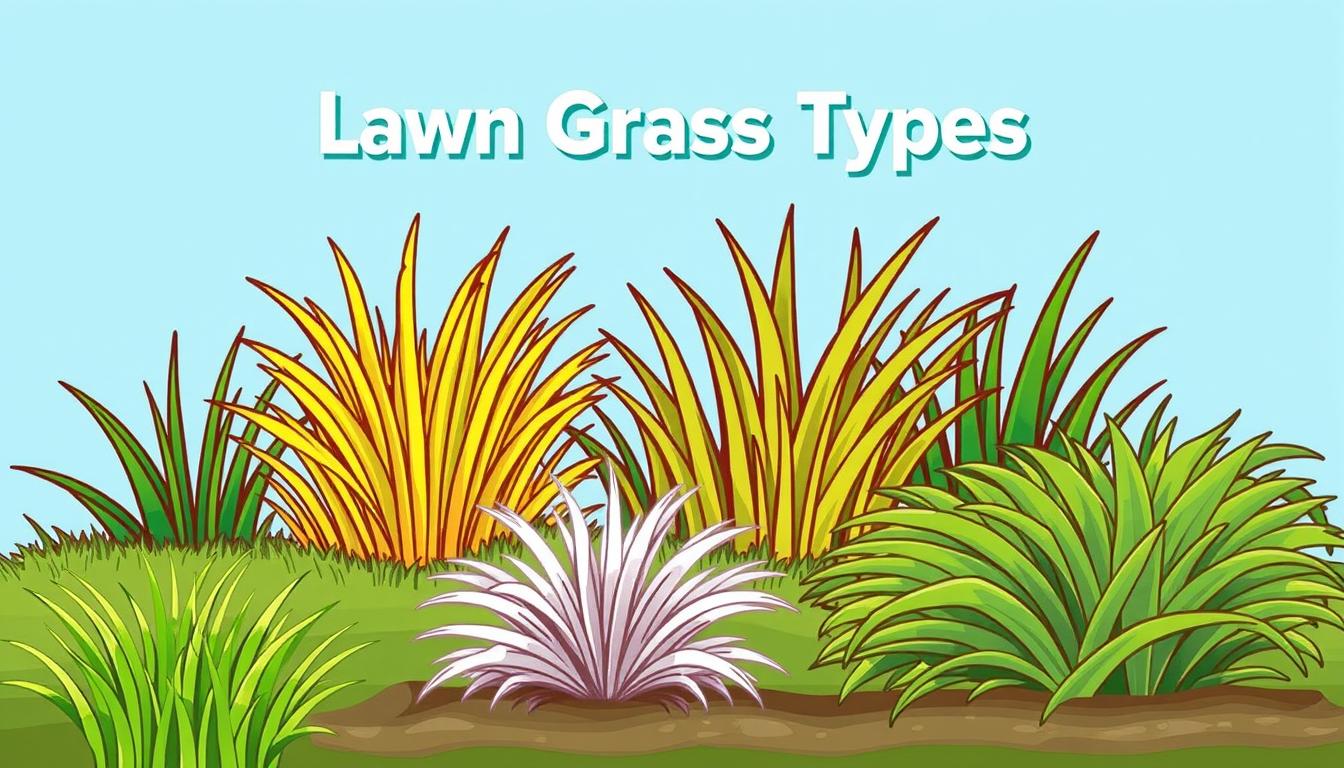
Did you know there are over 10,000 grass types worldwide for lawns?
With so many options, making your lawn lush and healthy can seem hard. But, knowing your grass’s unique needs can turn your yard into a green oasis. In this guide, I’ll help you identify lawn grass types and their care needs. This will make you a lawn care expert.
Key Takeaways
- There are over 10,000 different grass types worldwide for lawns.
- Grasses can be categorized as warm-season or cool-season based on their growing patterns.
- Grass types have varying tolerance levels for shade, foot traffic, and soil conditions.
- Choosing the right grass for your climate and landscape is crucial for a thriving lawn.
- Proper mowing, fertilizing, and watering practices are essential for maintaining a healthy lawn.
Identifying Lawn Grass
Before we dive into lawn care, it’s key to know the basics. Grass identification starts with grasping grass morphology and the grass plant structure. Each part has a role in growth and defense.
Common Grass Terms
Here are some common grass terms:
- Blade: The leaf of the grass plant
- Sheath: The lower part of the leaf that wraps around the stem
- Collar: The transition zone between the blade and sheath
- Culm: The stem of the grass plant
- Node: The joint on the culm where the leaves attach
- Internode: The segment of the culm between two nodes
- Root system: The network of roots that anchor the grass plant
- Tiller: A new shoot that emerges from the base of the plant
Structures and Characteristics of the Grass Plant
For grass identification, it’s important to know:
- Rhizomes: Underground stems that spread horizontally and produce new plants
- Stolons: Aboveground stems that spread horizontally and produce new plants
- Inflorescence: The flower cluster or seed head
- Veins: The network of vascular tissue that transports nutrients and water
- Leaf tips: The shape and texture of the leaf tips can vary among grass species
- Vegetative reproduction: The ability of the grass plant to propagate through its rhizomes, stolons, and tillers
Knowing grass morphology and grass plant structure is vital. It helps in accurately identifying lawn grass. This knowledge is key for effective lawn maintenance.
Warm-Season Grasses
Lawn grasses vary a lot in how they grow, look, and need sunlight, water, and nutrients. Warm-season grasses are special because they do well in the southern half of the U.S. They cover lawns, parks, and sports fields everywhere.
These grasses grow best in warm weather, from late spring to early fall. It’s important to keep the soil pH right, between 5.8 to 7.0. This helps them get the nutrients they need.
Some top warm-season grasses are Bermudagrass, Zoysia grass, and Centipede grass. Bermudagrass grows fast and needs to be mowed and fertilized often in summer. Zoysia and Centipede grasses need less care, with Centipede needing almost no fertilizer.
| Grass Type | Mowing Frequency | Fertilization Needs | Drought Tolerance |
|---|---|---|---|
| Bermudagrass | Twice weekly | Monthly during peak growth | High |
| Zoysia grass | Weekly | Moderate | High |
| Centipede grass | Weekly | Low | Moderate |
Warm-season grasses love the heat, growing well in temperatures up to 100 degrees Fahrenheit. But, they handle drought differently. Bermudagrass and Zoysia grass have deep roots to help them survive dry spells.
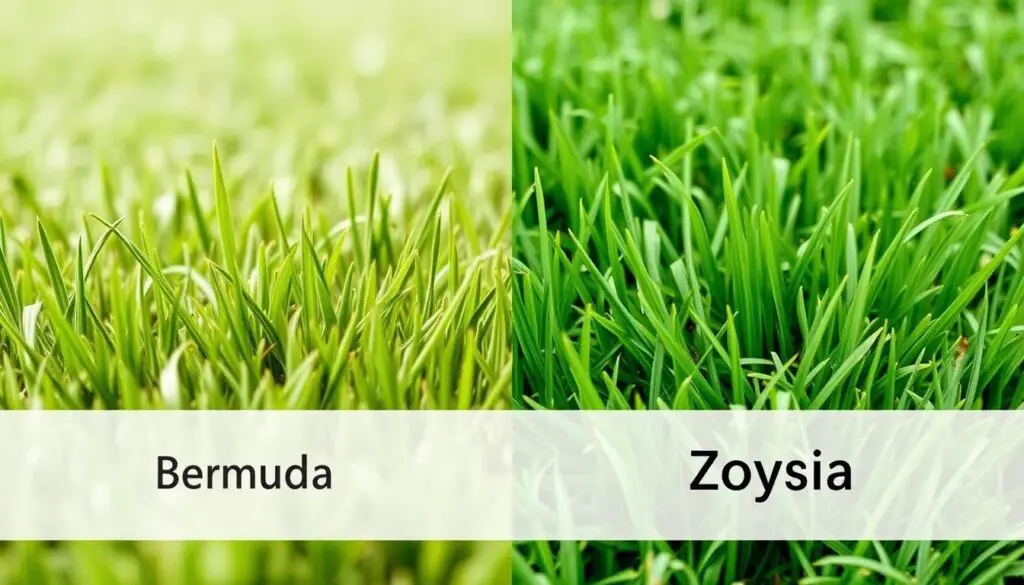
Bermudagrass doesn’t do well in shade and needs full sun. But, Bermudagrass and Zoysia grass are great for places with lots of foot traffic. They recover quickly from wear and tear.
Exploring warm-season grasses can help you create a beautiful lawn that lasts in the southern climate. Knowing what each grass needs is the first step to a lush outdoor space.
Bermudagrass
Bermudagrass (Cynodon spp.) is a top pick for warm-season grasses. It’s great for lawns, sports fields, and golf courses. This grass has a fine to medium texture and a vibrant green to blue-green color. It spreads quickly through rhizomes and stolons, making a dense and lush turf.
Identifying Bermudagrass
In the southern United States, bermudagrass is a common sight. It has a medium-fine blade width and grows flat. It also has seed heads in the summer. This grass is found from New Jersey and Maryland to Florida and as far west as Kansas and Texas.
Caring for Bermudagrass
Proper care is key for bermudagrass. It loves full sun and needs deep, infrequent watering. The best mowing height is between 1 to 2 inches for common varieties. Hybrid varieties do best at 1/2 to 1.5 inches.
Fertilize with a high-nitrogen formula in spring and summer. This helps it grow lush and green.
“Bermudagrass has been reported to have a higher drought tolerance than Zoysiagrass.” – Laura, lawn health expert
Bermudagrass is a reliable and low-maintenance choice. It’s perfect for high-traffic areas. Its ability to withstand wear and tear, plus its drought tolerance, make it a popular choice for a durable and attractive lawn.
Cool-Season Grasses
Choosing the right grass type is key to a lush, healthy lawn. Cool-season grasses are great for areas with big temperature swings. Summers are hot and dry, while winters are cold.
These grasses do well in spring and fall when it’s cooler. They might slow down in extreme heat.
Common cool-season grasses include Kentucky bluegrass, perennial ryegrass, fine fescue, and tall fescue. Each has its own needs and looks, so pick the best for your climate and lawn care.
| Grass Type | Drought Tolerance | Foot-Traffic Tolerance | Shade Tolerance | Cold Tolerance | Heat Tolerance |
|---|---|---|---|---|---|
| Kentucky Bluegrass | Medium | Medium | Low-Medium | Medium | Medium |
| Perennial Ryegrass | Low-Medium | High | Low-Medium | Medium | Low-Medium |
| Fine Fescue | High | Medium | High | Medium-High | Low-Medium |
| Tall Fescue | High | Medium-High | Medium | High | High |
Cool-season grasses are common in states like Delaware and Connecticut. They’re also found in Iowa, Illinois, and many others.
When picking a cool-season grass, think about your climate, foot traffic, shade, and how much care you want. With the right care, these grasses can make your outdoor space beautiful and inviting.
Kentucky Bluegrass
Kentucky bluegrass is known for its vibrant, lush lawns. It has a medium to dark green color and fine texture. Its boat-shaped leaf tips make it stand out.
It grows in dense mats and has a shallow root system. This makes it great for areas with a lot of foot traffic and needs less care.
Identifying Kentucky Bluegrass
Kentucky bluegrass is easy to spot because of its boat-shaped tips. Its medium to dark green color and fine texture are unique. It also grows in dense mats due to its rhizomatous growth.
Caring for Kentucky Bluegrass
To keep a Kentucky bluegrass lawn healthy, you need to pay attention. It loves full sun but can handle light shade. Water it deeply but not too often to help its roots grow strong.
Mow it at 4 to 6 inches tall. Fertilize it completely in early fall and spring. This helps it grow well and fight off diseases.
“Kentucky bluegrass has been a beloved lawn grass in the United States for decades, praised for its lush appearance and resilience. With proper care and maintenance, this cool-season grass can create an envy-worthy landscape that’s the pride of the neighborhood.”
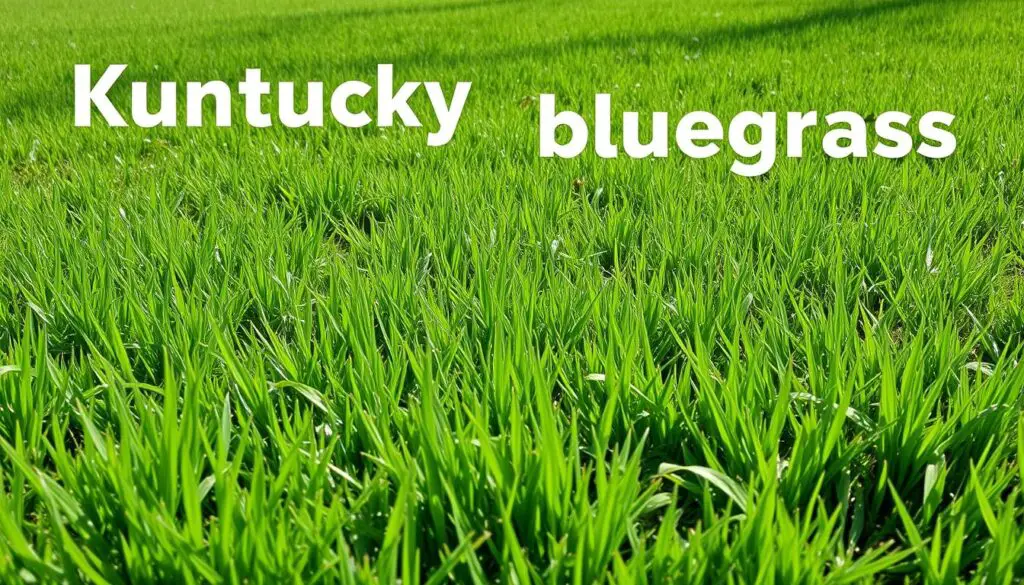
Kentucky bluegrass needs a bit more work than some other grasses. But the results are worth it. It’s hardy in winter, can fix itself, and grows densely. It’s a favorite for lawns in northern parts of the United States.
Grass Types
Understanding the different lawn grass types is key to a lush, healthy lawn. There are warm-season and cool-season grasses, and many other grass varieties to consider for your lawn.
The transition zone, between the north and south, is special. Here, grasses like Tall Fescue, Kentucky Bluegrass, and Ryegrass do well. They handle both heat and cold well.
- Tall Fescue is a cool-season grass that can take heat and lots of foot traffic. It’s great for athletic fields and busy areas.
- Kentucky Bluegrass is a cool-season favorite. It looks lush and is often mixed with Ryegrass and Fine Fescue in northern lawns.
- Ryegrass germinates fast and is easy to care for. It’s common in northern lawn mixes.
In the South, Bermudagrass, St. Augustine/Floratam, and Centipedegrass do well. These lawn grass types handle the South’s heat and traffic well.
Choosing the right grass varieties depends on your climate, soil, and how you’ll use the space. Knowing the unique traits of lawn grass types helps you pick the best for your lawn. Proper mowing techniques are vital for a healthy, beautiful lawn, no matter the grass types.
Fine Fescue
Fine fescue is a cool-season grass known for its beauty and strength. It has delicate leaves and a blue-green color. This grass is not just pretty; it also does well in shaded spots and different soils.
Identifying Fine Fescue
Fine fescue grows in tight clusters and is quite low. Its fine texture and blue-green color are easy to spot. All fine fescue varieties share these traits, making them easy to identify.
Caring for Fine Fescue
Keeping a fine fescue lawn healthy takes some effort but is rewarding. It loves shaded areas and well-drained soil. Make sure to water it regularly, and mow it to 4 to 6 inches. A light nitrogen fertilizer in spring or fall can also help.
Fine fescue is a favorite for those who love cool-season lawns. It’s great for shaded spots or if you want something easy to care for. With the right care, your fine fescue lawn will look beautiful for years.
| Grass Type | Identification | Care |
|---|---|---|
| Fine Fescue |
|
|
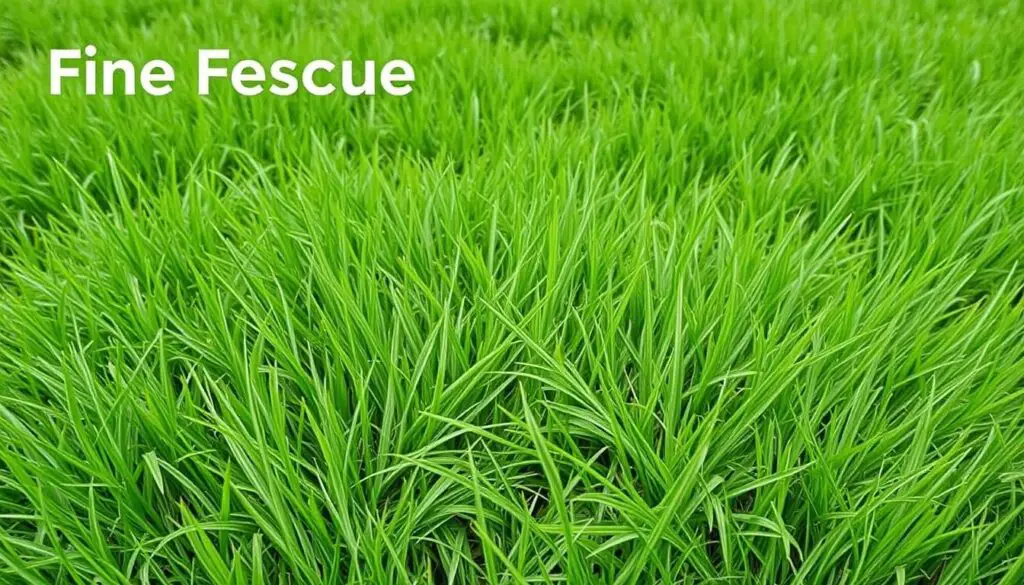
“Fine fescue is a resilient and adaptable cool-season grass that can thrive in a variety of conditions, making it a top choice for many homeowners.” – Sam, author of the blog
Centipede Grass
Centipede grass is a favorite for lawns in the southeastern U.S. It’s known for its light green color and coarse texture. This grass grows like a carpet and needs less care than others.
Identifying Centipede Grass
Centipede grass stands out with its light green color and coarse texture. It grows thick and carpet-like. Its shallow roots make it easy to care for.
Caring for Centipede Grass
To keep centipede grass healthy, it needs full sun and some shade. It likes consistent moisture but can’t handle too much water. Mow it to 2 to 3 inches and fertilize lightly in spring.
Soil pH is crucial for centipede grass. It prefers acidic soil, between 4.5 and 6.0 pH. Regular soil tests help keep the pH right.
Watch out for pests like mole crickets and chinch bugs. Quick action is key to keeping your lawn pest-free.
Knowing how to care for centipede grass leads to a beautiful, easy-to-maintain lawn. It’s perfect for the warm climates of the southeastern U.S.
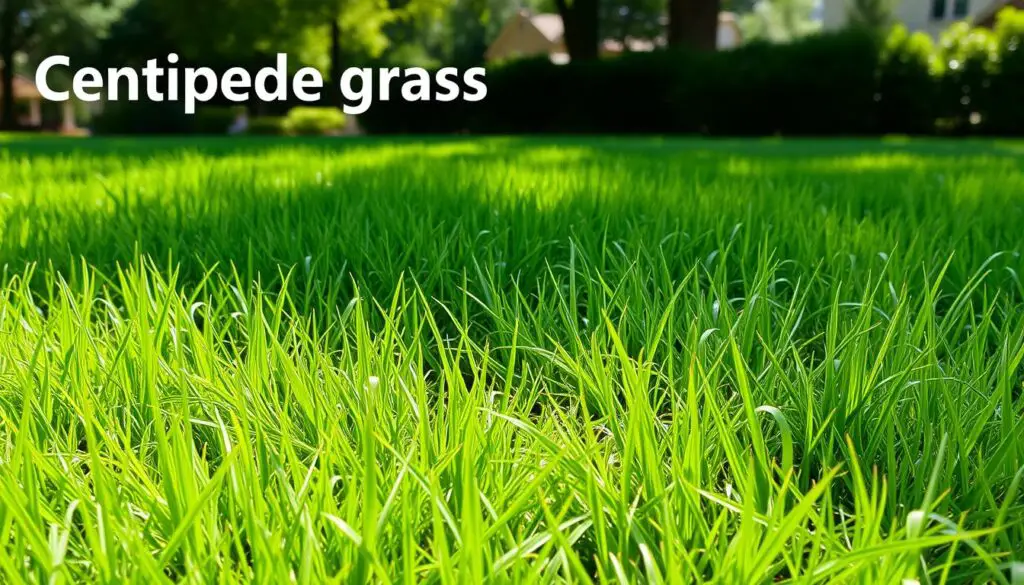
Zoysia Grass
Zoysia grass is a warm-season grass that’s perfect for a dense, uniform lawn with little upkeep. It’s loved by homeowners and landscapers for its great qualities.
This grass has a medium to fine texture and a bright green color. It grows slowly but forms a dense, carpet-like turf. It does well in full sun and even some shade, making it great for lawns and golf courses.
Zoysia grass is also very good at handling drought. Its deep roots help it keep moisture and stay green even when it’s dry. Plus, it needs less nitrogen, which is good for your wallet and the environment.
There are many zoysia grass varieties to choose from. Emerald Zoysia is great for shady areas. Zeon Zoysia is known for its vibrant color and soft texture. Empire Zoysia is the best for areas with a lot of foot traffic.
To keep your zoysia lawn looking its best, you need to mow it right and fertilize it in spring and summer. Water it deeply but not too often once it’s established. With these tips, you’ll have a beautiful, easy-to-care-for lawn.
Zoysia grass is a great choice for a new lawn or to improve your current outdoor space. It’s beautiful, resilient, and easy to care for. Its deep roots and ability to handle drought make it a top choice for a lush landscape.
Location and Climate Considerations
Choosing the right lawn grass depends on your home’s location and climate. Knowing the regional conditions is key. The climate’s effect on grass growth and care changes a lot by region.
Warm-season grasses love warm weather and grow well in hot summers. Cool-season grasses prefer cooler temperatures and do well in northern areas with mild summers and cool seasons.
The transition zone in the U.S. is tricky. It has cold winters and hot, humid summers. Here, a mix of warm and cool-season grasses works best for homeowners.
| Grass Type | Ideal Climate | Key Characteristics |
|---|---|---|
| Cool-Season Grasses | Northern regions with moderate summers and cool spring and fall |
|
| Warm-Season Grasses | Regions with extra high summer temperatures |
|
Understanding your local climate helps you pick the best lawn grass. This choice ensures your grass thrives with minimal care. It’s vital for grass types by region and the long-term health of your lawn.
Maintaining a Healthy Lawn
Keeping your lawn lush and vibrant is a big job. It needs regular care and attention. Knowing what your grass needs is key, whether it’s warm-season or cool-season. Mowing, watering, and fertilizing are musts for a great-looking lawn.
Mowing at the right height, 2-3 inches, helps your lawn grow well. It also keeps weeds away.
Mow weekly in the growing season and more often when the grass grows fast. Always cut no more than one-third of the blade height at a time to avoid stressing the lawn.
Watering right is very important, more so in dry summers. Your lawn needs about an inch of water a week. You can use rainfall or a sprinkler system with a timer. Also, aerating your lawn helps it absorb water and nutrients better, making it healthier and more resilient.
FAQ
What are the common types of lawn grasses?
How do I identify different lawn grasses?
What are the key considerations for caring for Bermuda grass?
How should I care for Kentucky Bluegrass?
What are the special requirements for Fine Fescue?
How do I care for Centipede Grass?
What are the key considerations for Zoysia Grass?
How do I choose the right lawn grass for my location?
What are the essential lawn maintenance tasks?
Source Links
- https://www.groundsguys.com/blog/2019/may/different-types-of-lawn-grasses/
- https://lawnlove.com/blog/guide-to-grass-types/
- https://www.lawndoctor.com/blog/how-know-what-type-grass-you-have/
- https://diypestcontrol.com/blog/lawn-grass-identification-guide.html?srsltid=AfmBOoqoLPpQiBCe_HrfAEULWMfNHBRT8vXwkfEmMza7vTRx-cMuipbZ
- https://naturesseed.com/blog/identifying-5-common-lawn-grass-species/
- https://www.pennington.com/all-products/grass-seed/resources/what-is-the-best-warm-season-grass-for-your-lawn
- https://lawnlove.com/blog/guide-to-warm-season-grasses/
- https://www.lawnstarter.com/blog/lawn-care-2/bermudagrass-guide/

